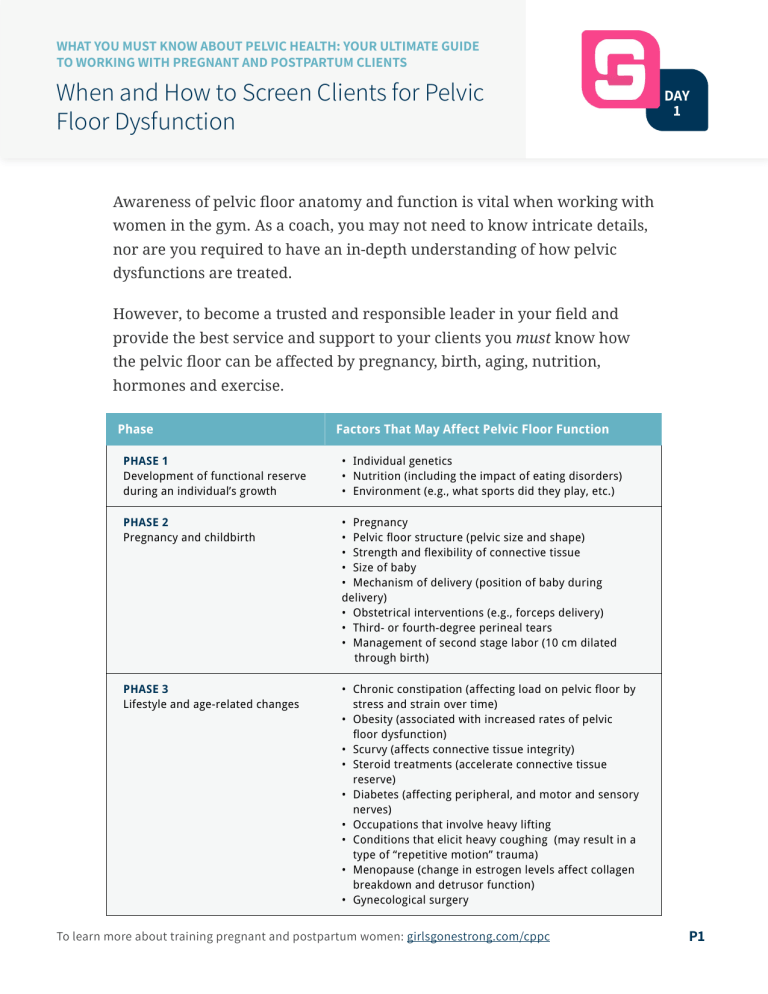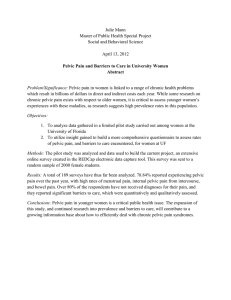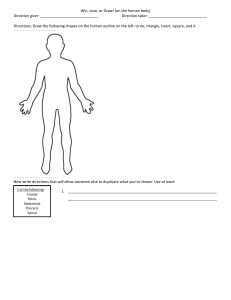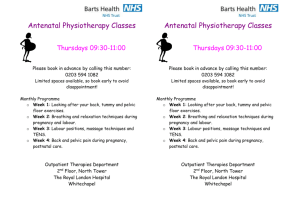
WHAT YOU MUST KNOW ABOUT PELVIC HEALTH: YOUR ULTIMATE GUIDE TO WORKING WITH PREGNANT AND POSTPARTUM CLIENTS When and How to Screen Clients for Pelvic Floor Dysfunction DAY 1 Awareness of pelvic floor anatomy and function is vital when working with women in the gym. As a coach, you may not need to know intricate details, nor are you required to have an in-depth understanding of how pelvic dysfunctions are treated. However, to become a trusted and responsible leader in your field and provide the best service and support to your clients you must know how the pelvic floor can be affected by pregnancy, birth, aging, nutrition, hormones and exercise. Phase Factors That May Affect Pelvic Floor Function PHASE 1 Development of functional reserve during an individual’s growth • Individual genetics • Nutrition (including the impact of eating disorders) • Environment (e.g., what sports did they play, etc.) PHASE 2 Pregnancy and childbirth • Pregnancy • Pelvic floor structure (pelvic size and shape) • Strength and flexibility of connective tissue • Size of baby • Mechanism of delivery (position of baby during delivery) • Obstetrical interventions (e.g., forceps delivery) • Third- or fourth-degree perineal tears • Management of second stage labor (10 cm dilated through birth) PHASE 3 Lifestyle and age-related changes • Chronic constipation (affecting load on pelvic floor by stress and strain over time) • Obesity (associated with increased rates of pelvic floor dysfunction) • Scurvy (affects connective tissue integrity) • Steroid treatments (accelerate connective tissue reserve) • Diabetes (affecting peripheral, and motor and sensory nerves) • Occupations that involve heavy lifting • Conditions that elicit heavy coughing (may result in a type of “repetitive motion” trauma) • Menopause (change in estrogen levels affect collagen breakdown and detrusor function) • Gynecological surgery To learn more about training pregnant and postpartum women: girlsgonestrong.com/cppc P1 Day 1: When and How to Screen Clients for Pelvic Floor Dysfunction Equally important is knowing how to screen clients for pelvic floor dysfunctions, being able to consider pelvic floor adaptations in pregnancy and the postnatal period when creating exercise programs, and knowing when and to whom you should refer a client when there is cause for concern. When to Screen for Pelvic Floor Dysfunction Before a new client starts an exercise program, it’s a good idea to screen for pelvic floor dysfunction. You may decide to screen your client again at a later date if circumstances change or if she mentions symptoms. Ideally, all women participating in an exercise program with a coach should be screened before starting. It’s also wise to screen clients for pelvic floor dysfunction when there’s a new situation, such as becoming pregnant, returning to exercise after giving birth (recently postpartum), or returning to exercise after surgery. How to Screen for Pelvic Floor Dysfunction When you’re assessing new clients before they start a training program, we recommend including a pelvic floor screen. The Pelvic Floor First Screening Tool from the Continence Foundation of Australia is easy to use and will help you determine when a client may need a referral to a pelvic health physiotherapist. It can also help guide conversations about pelvic floor health and inform how you design a client’s training program. If your client is pregnant, use: 11. The Physical Activity Readiness Medical Examination for Pregnancy (PARmed-X for Pregnancy) form from the Canadian Society of Exercise Physiology (to make sure she has medical clearance and is safe to exercise). 2. Download the PARmed-X for Pregnancy here To learn more about training pregnant and postpartum women: girlsgonestrong.com/cppc P2 Day 1: When and How to Screen Clients for Pelvic Floor Dysfunction 22. The Pelvic Floor Screening Checklist adapted from the Continence Foundation of Australia. Download the Pelvic Floor Screening Checklist here 3. If your client is postpartum*, use: 11. The Postpartum Physical Activity Readiness Questionnaire (P-PAR-Q) form we created for our Pre- & Postnatal Coaching Certification students. This form includes pelvic floor screening within the questionnaire. Download the Postpartum PAR-Q here *There is no universally agreed-upon timeline to determine at what point in postpartum you should stop administering the P-PAR-Q. Technically once a woman has a baby, she is considered postpartum forever, but over time the P-PAR-Q can become less relevant for some women. We recommend using the P-PAR-Q with women who have given birth anytime in the last three years. Otherwise, you can administer your standard PAR-Q and the Pelvic Floor First Screening Checklist we provide in the second bonus resource. If your client has many risk factors for pelvic floor dysfunction, you can always administer the P-PAR-Q later to learn more about her specific pregnancy and birth experiences. How you choose to perform the pelvic floor screening will depend on many factors: • Your relationship with the client • How comfortable you are with discussing the topic • Where you undertake the screening process (a busy gym floor versus a private room) • How much time you have available To learn more about training pregnant and postpartum women: girlsgonestrong.com/cppc P3 Day 1: When and How to Screen Clients for Pelvic Floor Dysfunction If a client is attending a group class or you don’t have an opportunity to spend a lot of one-on-one time with her, it is perfectly reasonable to hand over a paper screening form and ask her to fill it in. If she answers “yes” to any of the questions, you need to be able to provide her some guidance on where she should go from there. We recommend that you have some business cards or a list of pelvic health providers that you can recommend to her. If there are no pelvic health physiotherapists in close proximity, ask her to follow up with her GP or OB/GYN. If the circumstances allow and you feel comfortable doing so, you can verbally ask the client the questions on the form. This can allow you the opportunity to ask follow up questions and better gauge your client’s concerns on these matters. Having this conversation can also mean that you can discuss why pelvic health is important to long term health and the types of treatments that are available. Signs of Optimal Pelvic Floor Function Urinating six to eight times per day Signs of Pelvic Floor Dysfunction Increased frequency of urination (over six to eight times per day) No leaking of urine Can hold bladder and bowels to get to the toilet No discomfort with intercourse or penetration Leaking urine when coughing, sneezing, laughing, exercising or otherwise exerting oneself Can’t make it to the toilet in time Pain with intercourse or penetration No lumbar or pelvic pain Feeling of heaviness in the perineum Emptying bladder and bowel with ease No difficulty using a tampon Feeling of things “coming out” or “falling out” of the vagina Difficulty inserting a tampon To learn more about training pregnant and postpartum women: girlsgonestrong.com/cppc P4 Day 1: When and How to Screen Clients for Pelvic Floor Dysfunction Although a client’s responses to a questionnaire, along with a core assessment, can give you some insight as to whether or not pelvic floor dysfunction is present, you probably won’t know if she’s doing a pelvic floor muscle contraction effectively. This is where collaboration with a pelvic health physiotherapist is essential. When these muscles contract, they should feel like they’re drawing upward, not pushing downward. Some women bear down rather than drawing up when attempting to contract the pelvic floor muscles. If your client isn’t sure, encourage her to see a pelvic health physiotherapist who can perform internal work (if possible). Teach your client to administer a self-test. Your client can also test her pelvic floor muscles at home. If she is open to talking about it, and you feel comfortable recommending that she test her pelvic floor muscles herself, here are two quick tests she can try at home to see if her pelvic floor muscles are moving properly. If she doesn’t want to or can’t get to a pelvic health physiotherapist, these tests may be of some value to her. Give the following cues to try at home when she has some privacy: 14. “While standing in the shower, Insert one or two fingers into your vagina (about three-quarters of the finger length deep). Focus on drawing the pelvic floor muscles together and lifting them up toward your head. You should feel a squeeze and a lift around your fingers.” 25. “Sit on your hand and feel the pressure of the perineum on your hand. Focus on doing a pelvic floor contraction and feel the lift of the perineum up and away from your hand. As you relax the muscles, feel them descend back toward the hand.” To learn more about training pregnant and postpartum women: girlsgonestrong.com/cppc P5 Day 1: When and How to Screen Clients for Pelvic Floor Dysfunction If your client has a physioball (also known as a stability ball or a Swiss ball), doing these exercises sitting on the ball may help her feel the perineum lifting away from the ball. These two quick self-tests are useful to give your clients a basic idea if the pelvic floor is contracting and elevating only. If she does these tests and does not feel much movement, or she feels the pelvic floor moving the opposite way to expected (i.e. downwards when contracting), then she could see a pelvic health physio for further evaluation. Most health and fitness professionals do not discuss pelvic health with their clients. With a good understanding of the pelvic floor and its response to exercise, you can help your clients achieve better outcomes. By completing this free course, you are taking the first steps toward joining a revolution in the fitness industry — a revolution in which the discussion of pelvic health is common (not “weird” or “gross” or even unusual) and is integral to a client’s training program. When you are equipped to discuss, demystify, and incorporate pelvic floor health in your training programs, you will help countless women seek treatment early, stay active, enjoy great sex, and ultimately, enhance their quality of life. How to Find a Pelvic Health Physiotherapist In Your Area (for Yourself or Your Client) Click here for a FREE download to help you find a pelvic health physio in your area (and to learn more about how to help clients who don’t have a physio in their area). To learn more about training pregnant and postpartum women: girlsgonestrong.com/cppc P6



